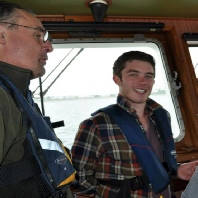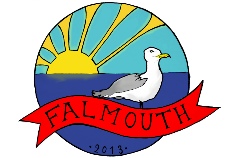
About
Introduction
From the 23rd June - 5th of July, students from the University of Southampton took part in a field course based in Falmouth, Cornwall, UK. This site, produced by group 2, who collected data between 24th June - 1st July aims to consolidate and summarise key experimental procedures and findings of the course.
The aim of this field course was to directly study interrelated physical, chemical and biological processes occurring within estuaries and coastal seas; concepts taught during the SOES 2024 and 2027 modules of Coastal and Estuarine Oceanography.
Physical parameters including wind, currents, mixing, water column stability and fluid-sediment interactions combined with chemical parameters such as nutrient concentration gradients ultimately, affect the biological parameters measured such as zooplankton and phytoplankton distribution. The temporal and spatial variability of these were studied with particular interest.
Data Collection
Data was collected over a number of sites with a variety of techniques. Each site has been allocated its own page on which these techniques have described.
- Fal Estuary: surveyed 24th June with R.V. Bill Conway
- King Harry Pontoon: a fixed location in the Fal surveyed the morning of 26th June as part of a collaborative time series project with other groups.
- Falmouth Bay: seabed geomorphology surveyed 27th with the Viking
- Offshore: surveyed 29th June with R.V. Callista
- Additional subsequent lab work on the samples and data collected at the Fal Estuary, Falmouth Bay and offshore was conducted on the 25th, 28th June and 1st July, respectively.
Falmouth Bay
Maerl has been extracted from dredge oozes in the Fal since the 17th century, (Ray, 1690) to produce manure and soil conditioner. Since the cessation of exploitation in 1850, the Cornish Calcified Seaweed Company (CCSC), which extracts up to 30,000 tonnes per annum, had, until recently, restarted extracting dead maerl deposits (White, 2004). In 1995, Davies and Sotheran defined 5 distinctive biotopes in Falmouth Bay, strongly characterised by these extensive deposits of dead maerl and associated derivatives (Hardiman, Rolfe and White, 1976). Through the use of baseline mapping surveys to assess the geographic distribution of living and dead forms it is possible to successfully monitor the exploitation of living resources such as maerl (Davies and Sotheran, 1995). In addition to the maerl, the sediment composition has recently been influenced by the addition of dredgings from the Fal marina, deposited by bottom dump barges at an offshore spoil ground disposal site (Wathen, 2010).
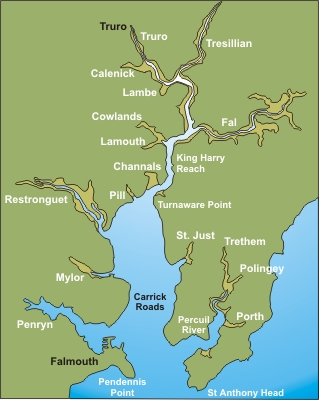
The Fal Estuary
The Fal estuary, situated in Cornwall, in a ria containing a number of tidal creeks. Such drowned river valleys commonly form by tectonic subsidence and/or a rise in sea leveland have a similar topography to river valleys. Fluvial influence of ria systems like the Fal are very small and they are almost completely influenced by the marine system. Terrestrial inputs from surface run off are also highly influential, adding heavy metal residues such as Cu, Zn, As, Cd and Fe from 20th century mining activities into the Fal through run-off. Although the last mine was closed in 1991, a marked gradient in sediment metal concentrations is still evident.
The Fal estuary has been identified as a Special Area of Conservation (SAC) and is protected under the European Union’s ‘Habitat Directive’ as part of a global attempt to conserve biodiversity. Mixing between warm Gulf Stream currents and cold North Atlantic waters provides a habitat on the edge of a number of species thermal tolerance limits. Along with extremely varied underwater topography, strong tidal influence and, occasionally, storms that promote upwelling of nutrients to the surface, the Fal estuary and surrounding marine habitats have become extremely diverse. The habitats around Falmouth are home to a number of species of dolphin, such as the common (Delphinus spp.), bottlenose (Tursiops spp.) and Risso’s dolphin (Grampus griseus) and also a number of birds such as cormorants and gannets. More information can be found at http://www.falriver.co.uk/sac. The implementation of SAClegislation in recent years has also prohibited dredging activity in Falmouth Bay to protect rich and diverse local habitats and biota.
In estuarine waters, physical characteristics are often determined by the type of estuary and the tidal regime. Estuaries that undergo high tidal influence tend to be well mixed, whereas estuaries that undergo low tidal influence tend to form salt wedges. Chemical distributions along estuaries are also important in understanding the dynamics of the system. Chemical inputs from rivers travel down the estuary to the ocean. Collecting data on chemical concentrations along the estuary can provide information as to whether they are behaving conservatively or non-conservatively. If a particular constituent is behaving non-conservatively then it is then important to understand the process that is driving removal or addition. Additional inputs could be anthropogenic and therefore need to be understood. Removal can occur through biological or chemical processes along the estuary. For example, removal of silicon could be due to a diatom bloom along the estuary.
Estuaries and coastal seas undergo a seasonal cycle with regards to their physics, chemistry and biology. Seasonal variations in wind can affect the amount of mixing occurring along with temperature in offshore waters. In cold winter months, cold water continuously sinks, promoting mixing whereas in the summer months, thermal stratification occurs due to increased surface water temperature, restricting the amount of mixing. These seasonal variations can affect the chemistry and biology of the water column. During winter months, nutrients are brought to the surface through upwelling. However, insufficient sunlight during these months restricts phytoplankton growth. During spring, as sunlight increases, there is typically a phytoplankton bloom which uses up these surface nutrients. As stratification increases, and mixing is restricted, less and less nutrients can be brought to the surface waters.
Group 2
References
Davies, J. and Sotheran, I. 1995, ‘Mapping the distribution of benthic biotopes in Falmouth Bay and the lower Fal Ruan Estuary’, English Nature Research Reports, 119a.
Hardiman, P.J., Rolfe, M.S. and White, I.C. 1976, ‘Lithothamnium studies off the south-west coast of England’, ICES report no CM1979/K:9.
White, N. 2004, ‘Marine ecological survey of the Fal estuary; effects of maerl extraction’, Royal Haskoning on behalf of Falmouth Harbour Commissioners, REF: 9M5679/R1/NSW/Exet
Wathen, C. 2010,’Falmouth Marina Dredging – Environmental Impact Assessment’, Hyder Consulting UK Ltd on behalf of Premier Marinas, REF: 5012-DV01335-NHR-01

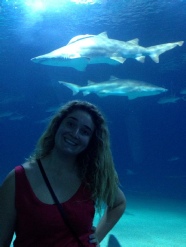

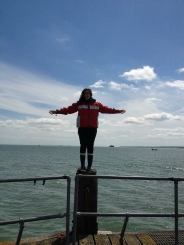
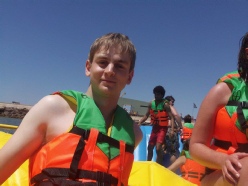



Left to Right: Eddy Kirk, Irene Fobe, Jessie Melton, Rosalie Timmerman, Sam Eglund Newby, Tom Bourner, Caitlin Phelps, Sam Kirby and Laura Oades
